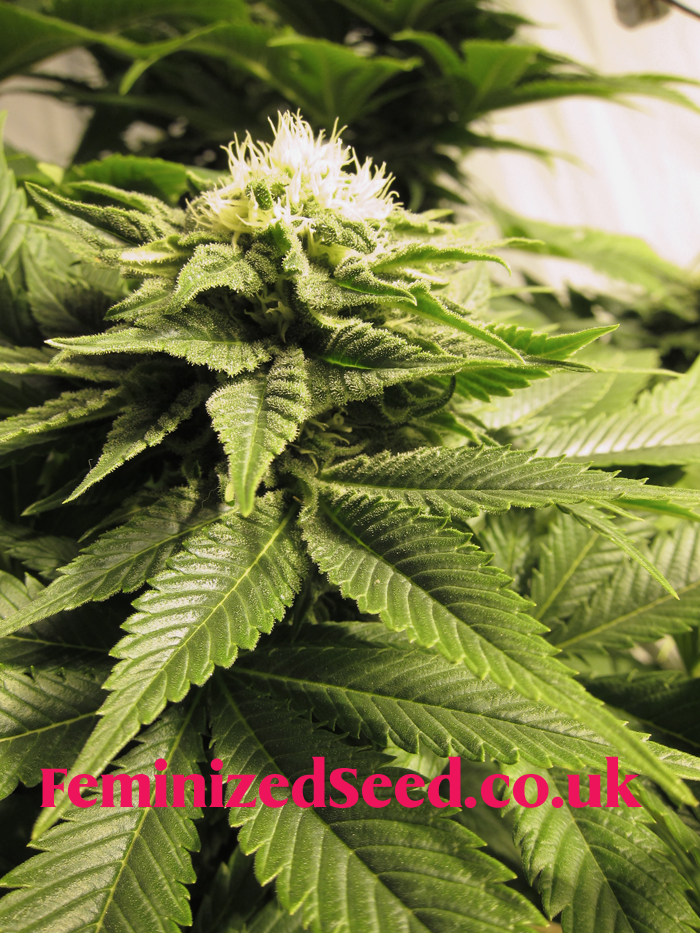|
Di seguito gli interventi pubblicati in questa sezione, in ordine cronologico.
Published in the December 2013 issue of Epilepsy & Behavior, the survey compiled responses from 18 parents who had turned to CBD (cannabidiol)-rich cannabis extract to treat their child's severe epilepsy.
Of those surveyed, 83% indicated a reduction in their child's seizure frequency. Parents reported little to no side-effects of cannabis treatment, and, in some cases, a reduction in seizure frequency of up to 80%.

Thirteen of the children suffered from Dravet syndrome, four had Doose syndrome, one had Lennox-Gastaut syndrome and one had idiopathic epilepsy.
The study was led by postdoctoral fellow Catherine Jacobson, PhD, who believes in spite of the study's obvious weaknesses, that the results still support CBD-rich cannabis as an effective epilepsy medicine.
"Even given the caveats of the study, which are big, I believe that CBD will work for some children that are currently still seizing despite their trials of available anti-seizure drugs."
Dr. Jacobson says she was inspired to conduct the study by her own search for a treatment that could help her epileptic son. After hearing that some parents were having success using CBD-rich cannabis, she reviewed the literature and found research dating back to the 1970s that supported the anecdotes.
And while medical marijuana is legal in her home state of California, Dr. Jacobson believes that more research needs to be done in order for CBD to be widely accepted and available.
"Now the work begins, though, to find out which types of epilepsy it's going to help, how CBD interacts with other anti-seizure drugs, and what really are the side-effects?"
CBD remains strictly prohibited as a Schedule I drug, making it difficult for parents in many states to access the treatment. However, significant progress has been made in the past year towards achieving federal recognition of CBD as a medicine.
In fact, Dr. Jacobson is now part of a team at University of California, San Francisco (UCSF) that is leading clinical investigations on a high-grade CBD extract developed by GW Pharmaceuticals.
Just last month, the company announced that it had received FDA approval to begin experimental treatments with the new drug, Epidiolex, in epileptic children.
Research is being led by Roberta Cilio, MD, PhD at UCSF and Orrin Devinsky, MD at the NYU School of Medicine, and initial results are expected.
Source: LeafScience
GW Pharmaceuticals announced that it has been issued a Notice of Allowance from the U.S. Patent Office for a patent application involving the use of THC and CBD, the two main chemicals in marijuana, for treating gliomas.
Once a patent application is deemed a genuine invention, the Patent Office sends a Notice of Allowance that outlines the fees involved with final approval.

Specifically, the company provides this description of the patent:
"The subject patent specifically covers a method for treating glioma in a human using a combination of cannabidiol (CBD) and tetrahydrocannabinol (THC) wherein the cannabinoids are in a ratio of from 1:1 to 1:20 (THC:CBD) with the intent to reduce cell viability, inhibit cell growth or reduce tumor volume."
Filed in 2009, GW's patent application lists Otsuka Pharmaceutical as a collaborator and initially claimed the invention of the "use of a combination of cannabinoids in the manufacture of a medicament for use in the treatment of cancer."
However, it's likely that the application was revised since then to be more specific in its claims, including the ratio of THC to CBD used and the type of cancer treated.
Indeed, the use of cannabis and cannabis-derived chemicals to fight a wide range of cancers has long been suggested by pre-clinical research as well as anecdotal reports.
On the other hand, the first clinical trial to investigate these cancer treatments only began in november 2013, launched by GW Pharmaceuticals for their cannabis drug Sativex.
The trial investigates Sativex in combination with the standard chemotherapy drug temozolomide, and involves 20 patients with recurrent glioblastoma multiforme (GBM), an aggressive and rare form of brain cancer.
GW Pharmaceuticals also announced in November 2013 that it had begun human trials of a CBD-rich cannabis drug for the treatment of pediatric epilepsy.
Source: LeafScience
The work is being led by Dutch chemist and nanoparticle expert Willem Mulder, PhD, who has served as director of the Nanomedicine Laboratory at Mount Sinai since founding it in 2006.

Dr. Mulder and his team specialize in the use of nanoparticles in heart disease, and have recently taken an interest in the therapeutic potential of cannabinoids – a class of compounds found in marijuana.
Since 2005, pre-clinical evidence has shown that cannabinoids can slow the progression of atherosclerosis – a disease of the arteries that underlies various heart conditions – in mice.

Cannabinoids appear to be a promising treatment because of their anti-inflammatory properties. However, research in humans faces a number of barriers.
Dr. Mulder and his team believe that creating nano-drugs from cannabinoids may help to overcome one of the largest of these barriers: the 'high.'
Dr. Mulder has previously shown that nanoparticles, which are composed of an outer layer of fatty molecules, possess a natural attraction to the atherosclerotic plaque that accumulates on the inner walls of blood vessels.
By delivering cannabinoids via nanoparticles, Dr. Mulder says the drugs will never have to reach the brain, thereby avoiding any psychoactive effects.
Dr. Mulder told AD.nl in a recent interview that he hopes to start the first human trials sometime in the next 5 years. But in total, he says it could take 15 years for the therapy to reach the clinic.
Funding is another major obstacle of his research. In order to raise support for his work, Dr. Mulder has partnered with a team of Dutch filmmakers that are documenting his progress.
Led by Gert van Kempen, the High On Nano project will release a series of short films that will help bring the research to the public eye. They plan to raise €30,000 in order to begin production of the first episode by Spring 2014.
Source: AD.nl via LeafScience
Researchers at Brigham and Women's Hospital and Harvard Medical School conducted a study comparing the psychoactive effects of Marinol (scientific name: dronabinol) – a THC pill used to treat nausea and weight loss in AIDS and cancer – with smoked marijuana.
Published in The Clinical Journal Of Pain, the team concluded that both forms of cannabis treatment have similar psychoactive effects.

"These findings imply that in our laboratory environment, dronabinol caused a 'high' similar to smoking marijuana when used for pain management."
Marinol was given to a group of 30 chronic pain patients who were also on opioid therapy. Their measurements were compared with 20 healthy subjects who received marijuana in joint form.
The study involved three separate laboratory visits, where participants were given the drugs and asked to complete a self-rated assessment commonly used to measure psychoactivity.
Although psychoactivity scores came back the same, the researchers did notice a difference in the time it took for effects to peak. The effects of marijuana peaked after 30 minutes, while Marinol's peak happened at around 2 hours.
The researchers suggest that a delayed peak may make Marinol less abuse-prone than smoked marijuana.
On the other hand, medical marijuana can be administered in edible form, which many say offers a similar delay. A recent study also suggests that patients who've tried different forms of marijuana prefer the whole plant over pharmaceutical preparations.
Nevertheless, the authors believe that increasing interest in cannabis-based medicine warrants further research on its abuse potential.
The study received funding from the National Institute on Drug Abuse (NIDA) and Solvay Pharmaceuticals, Inc.
Source: LeafScience
Researchers at the University of Nottingham conducted a meta-analysis of previous studies, reports the Nottingham Post, concluding that cannabinoids could reduce the severity of stroke as well as improve neurological outcomes.

Lead author Dr. Tim England, honorary consultant stroke physician at the University of Nottingham and Royal Derby Hospital, presented the findings at this week's annual UK Stroke Forum conference.
Dr. England explained in an university release that while research thus far has been limited to animals, the latest findings provide support for human studies.

"This meta-analysis of pre-clinical stroke studies provides valuable information on the existing, and importantly, missing data on the use of cannabinoids as a potential treatment for stroke patients. The data are guiding the next steps in experimental stroke in order to be able to progress onto initial safety assessments in a clinical trial."
Dr. England and his team examined 94 past studies involving the effects of various cannabinoids on 1022 rats, mice or monkeys, reports The New Zealand Herald. The effects on stroke seemed to be consistent across all three types of cannabinoids: synthetic, marijuana-derived and those naturally produced by the body.
Dr. Dale Webb, director of research and information at the Stroke Association, also concluded that scientists should now aim to replicate the findings in humans.
"The findings have identified the potential for cannabinoids to reduce brain damage caused by stroke. Further research is needed to investigate whether cannabinoids have the same effects in humans: the effects of cannabis on the brain are highly complex and it remains a risky substance."
Following the presentation of the findings, Dr. Madina Kara, a neuroscientist at the Stroke Association, said that human trials are now "under discussion."
Source: NottinghamPost & NewZealandHerald via LeafScience
The issue is, despite marijuana being legal in over 20 states, only a handful have implemented measures to ensure product quality.
For instance, in California, laboratory testing is completely optional. And that's bad news, warns Jeffrey Raber, who holds a Ph.D in chemistry and runs a marijuana testing lab called The Werc Shop.

According to Dr. Raber, pesticides are present in about 10% of samples that are sent to The Werc Shop. While mandatory lab testing would be the ideal solution, Dr. Raber recently set out to determine just how much risk pesticides really pose.
His study, published in the Journal of Toxicology, shows that using a filtered smoking device can drastically reduce the conversion of pesticides into inhalable smoke.
Dr. Raber and his team used a McFinn's Triple Filtered Water Pipe for the study, which filters smoke through both cotton and carbon layers.
Unfiltered pipes and bongs, however, appear to offer far less protection against pesticides.
While research has yet to identify the specific health effects of smoking contaminated marijuana, Dr. Raber believes that patients with compromised immune systems are most at risk.
Source: Times-Standard via LeafScience
1 – Cannabis seeds contain the "genotype" of the plant, the genetic code which provides the instructions for building the finished "phenotype". This DNA is often a hybrid of genetics from the three recognized cannabis sub-species: Sativa, Indica and Ruderalis.
2 – Many of the commercially available cannabis seeds are feminized: this means that they are likely (but not guaranteed!) to produce female plants rather than male ones. This is very handy for breeders who otherwise have to great lengths to make sure that they separate the male from the female plants.

3 – Genetics from the Ruderalis sub-species are often included in popular strains because this is the only one of the three main types which flowers based on age rather than the length of daylight exposure – thus creating autoflowering seeds. This, along with the fact that Ruderalis is a very hardy herb, means that it is prized for creating hybrids even though its natural THC content is extremely low.
4 – Cannabis seeds can be stored for years without significantly reducing their viability. They need to be somewhere dry, dark and cool; ideally they should be stored at around 6C, and in an air-tight or vacuum-packed container.
5 – The majority of cannabis seeds on the market are hybrids from a dizzying lineage of cross-breeds. Seeds of landrace strains are different: they’re from plants which occur naturally in the wild, and their genetics have been shaped by natural – rather than artificial – selection.
6 – Hemp oil, which is produced by pressing cannabis seeds, is used in the manufacture of a wide range of beauty products and plastics, but it is also prized as a food supplement because of its high levels of essential fatty acids (EFAs). The seeds themselves contain no THC, so hemp oil is not psychoactive.
7 – Cannabis is a pretty hardy weed, so it isn’t actually that difficult to get the seeds to turn into seedlings: they will grow whenever and wherever they get the chance. To germinate they need moisture, warmth and a little bit of time. Most seeds will start to produce roots within 72 hours of being tucked up somewhere damp and humid, and although they are very delicate at this stage, they will grow quickly if they get sufficient sunlight and nutrition.
8 – Cannabis seeds have been found on a wide range of archaeological sites, including in Viking ship burials and within the tombs of Chinese mummies. Often they appear in contexts where hemp was not widely used for rope or textiles, suggesting that it was the THC which appealed to the people who left the seeds there.
9 – In southern Poland there is a traditional soup called siemieniotka which is made from cannabis seeds. It is traditionally enjoyed at Wigilia, the Christmas Eve supper that forms the focal point of the Christmas festivities.
10 – The law regarding cannabis seeds changes from country to country – and even within countries. So while it’s perfectly legal to purchase and own cannabis seeds in many countries please check your local laws to make sure that owning a few seeds is not going to land you up in jail!
Seedscanner is currently comparing over 12,000 cannabis seeds (and counting!)
Source: ismokemag
There are many reasons why people smoke marijuana. Some do it recreationally, some for medical purposes, and even some who consider it a part of their religion or spirituality.
In ancient times, cannabis was used in India by Hindu saints. Herodotus, an ancient Greek historian, wrote about its use in ceremonial practices by the Scythians, who were an Iranian tribe known for their use of horses.
In more recent times, the Rastafari movement that began in Jamaica promotes the spiritual use of marijuana. They use it as a way to worship their messiah, Haile Selassie, and as an aid to meditation. Rastafaris believe cannabis was the tree of life as described in the book of Genesis. Its use is sacramental and deeply religious, and it is believed smoking brings one closer to God. However, it is not necessary to smoke marijuana to be a Rastafari.

The Rastafari are not the only ones who hold this view of marijuana. In the year 2000 Roger Christie founded what is now known as the THC Ministry. In this religion, cannabis is considered to be a sacrament, not unlike communion. Members practice their religion with an emphasis on cannabis' healing and enlightening properties.
The cornerstone of the THC Ministry's belief is that the cultivation and use of marijuana is a human right provided by God and protected by the constitution. They believe cannabis was the original sacrament of almost every major world religion, and that the plant has the ability to satisfy our every desire.
The church's mission involves promoting use of the hemp plant and opening people's eyes to its benefits, and it is active in the legal and social issues surrounding its use in the Unites States. However, they ran into trouble with the law in 2010, when the founder and a few others associated with the ministry were accused of marijuana possession and trafficking. Since then, Christie has been in and out of court defending his beliefs.
Religions like Rastafari and the THC Ministry fall under an umbrella term called Cantheism. This is a modern term used for religions who base their beliefs on how awesome the cannabis plant is, while neither endorsing or condemning other religions or faiths that do not agree. Adherents to these religions can be known as cantheists, or cannabists. A treatise describing all the beliefs associated with Cantheism can be found here.
My favorite part about Cantheism is how seriously it approaches the matter. For example, the very first creed states: "I believe that Cannabis sativa is the useful cane and the true hemp." Part of the Cantheist code also states that followers "will share (their) faith, but not be obnoxious about it." In this kind of situation, I think it's important that religions centered around marijuana appear serious and professional, lest they be judged as a religion of pot heads.
Other churches, like the Universal Life Church, are welcoming to people who would consider themselves cantheists. Those who feel strongly about such matters and want to take it to the next level can even get ordained for free. The only requirement is that one's beliefs and practices may not discriminate or infringe on the rights of others.
While I personally have a more conservative approach, and would disagree with the notion of uniting cannabis and religion or spirituality, I understand why some choose to follow this path. Those who do should take it seriously, though, because faith and spirituality are serious things. With the way things are changing in the United States regarding marijuana laws, it seems logical to assume Cantheism will become more prevalent.
Source: weedist
A foodie “gastro-guide” who was profiled last year for his popular food tours of Seattle that he personalizes, Bryce Lathrop from the White Mustache Urban Adventures is all set to add on to his set of specialized events, “high-end all-inclusive marijuana adventure”.

First Tour Slated on April 2, 2014
The first tour is said to take place on 2th of April. Lathrop is organizing the event to be a multi-day one which will include classes for cooking savory items as well as sweet items using marijuana along with a “behind the scenes access to dispensaries, head shops, and grow facilities,” that carries a promise of eating of loads of goodies and food in a “legal and responsible” way. Just as his other food tours, Lathrop and his other guides will be driving the participants of the tours themselves like always between the stops. Lathrop adds with great gusto -“There is zero reason for these people to have to drive or do anything; I’m tucking them in at the hotel at the end of the evening.” The drive to the hotel will be after a stop for a late night snack in a place like Dick’s Drive-in or even Loretta’s North Western in South Park. The total cost of the multi-day tours which includes about 3 nights in a, what Lathrop calls “5-star Seattle downtown hotel,” is $1420.
Legalization of Weed in Seattle Has Brought a Radical Change

Ever since marijuana was legalized in the Seattle, Lathrop reveals that he has been contacted by several potential pot tour takers; his tour business covers places like Vancouver and Portland. He is known to conduct a number of themed and specialized events like a tour he calls “Musical plates” that is a perfect combination of live music and food. When he was initially suggested to do pot tours, he turned it down. But one fine day, a client pointed out how extremely successful such ventures have been in Denver (where pots are legalized), he decided to give it a shot. Since a lot of food tours happen in the evenings, he decided the pot tour could help get his licensed limousine company engaged during off hours. He said,“Denver is really trying to pitch itself as the New Amsterdam, so I’m sure Seattle’s going to do it too. I just really wanted to be the first.” While he has been advertising this tour to travellers, many citizens of Seattle have requested him on his Facebook page to do scaled-down versions of this tour that is specialized for Seattleites.
Source: Feminizedseeds
Tourism in Colorado Boosted with Legalization of Marijuana
Since January 1, 2014 marijuana use was legalized in Colorado along with Washington. All the Cannabis supporters were happy with the state’s decision to legalize recreational marijuana. Marijuana business is just booming and companies already fear shortage. After this new legislation in Colorado, the increasing touristic affluence has greatly benefitted the private companies, majorly because of those people who look forward to participating in various activities involving recreational uses of marijuana. “I think it is a great idea, showing people around, showing people the different programs, showing them the different types of weed, showing them the different areas,” said cannabis tourist Debbie Grossett. Companies have included cannabis as a main subject while offering tourist packages, which involve cannabis cooking classes as well. Chefs demonstrate different ways of cooking by using cannabis in various dishes. For vacationers looking for an alternative relaxing vacation with joints rather than a beach vacation, Colorado is surely the place to go.

The Green Tours!
Tourists are also given the opportunity to explore marijuana fields, events, and parties that provide insights into the consumption and use of marijuana. These tours are famous by the term “green tours” and gaining popularity and acceptance from people who are curious to get information on cannabis. The tourist information desk at the Denver International Airport offers a list of around 20 facilities where marijuana selling and buying is legal. There are “bus ferries”, which take tourists for a tour of three marijuana dispensaries for about $399, excluding the cost of marijuana that they may buy over and above that!
Limitation on Possessing Marijuana
There is lot of leeway for the citizens of Colorado towards pot culture. One ounce per visit could be bought by the adults (21 years and older), and they can smoke it in privacy at their homes. However, visitors have restrictive access to marijuana. There are several federal and state laws which limit the tourists to buy a quarter ounce only, while there are consumption restrictions as well.
No Smoking Zones
The “No Smoking” zones include forests, Ski Mountains, historic sites, trails, national parks, and federal land. Hotels, restaurants, entertainment venues, and bars are covered by Clean Indoor Act, and these would also come under no smoking permission, including outdoor public spaces. Marijuana dispensaries have clearly put up instructions about the dos and don’ts related to the use of marijuana on their premises. Leftovers cannot be taken home. Tony Verzura, the co-founder of RiverRock dispensary in Denver stated, “You need to come educated about local laws and be prepared to ensure complete compliance, and avoid unnecessary trouble.” Though the current marijuana tourism revenues are impressive, its fortune may or may not be favorable. Of course, it has America’s first marijuana recreational shops , but Washington will soon follow the same this year.
Source: Cannabis News Network
|